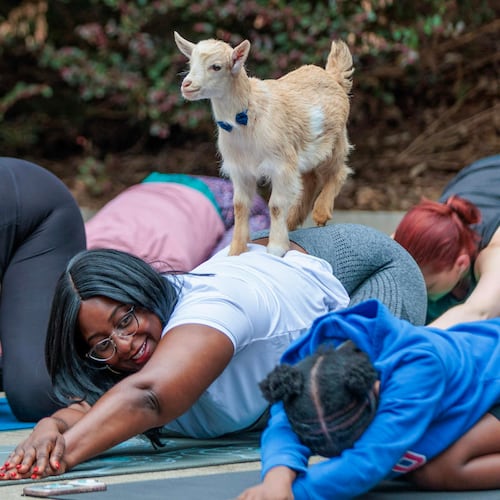A tsunami of pink swept through metro Atlanta this past weekend – pink drinks, pink dresses, pink products. All of it was in celebration of the recently released “Barbie” movie, a PG-13 comedy that, as of Monday, was the top grossing debut of the year at $155 million.
According to Variety, audiences (mostly female) and critics loved the film. I have to trust them because, so far, I haven’t been able to see the Greta Gerwig-directed movie. The theater in my neighborhood has been sold out except for the vertigo-inducing front row seats, and I could not muster enough enthusiasm to drive more than 2 miles out of my way to a theater with better available seating.
My feelings about Barbie have shifted in the 45 years since I received my first one — a Malibu Barbie. The recent hoopla has forced me to think more deeply about my relationship to this icon.
To be a woman in American society is to exist in a whirlwind of contradictions. Even if we can’t always support Barbie or see ourselves in many of her different variations, some of us can at least empathize with her struggle to stay relevant over the past 64 years. Barbie has survived changing times and, in that way, there’s a little Barbie in all of us of a certain age. She’s shown her resiliency again and again. She has been showered with love over the decades, but also has survived constant criticism and the sting of being hated.
Growing up, I played with the only Barbie dolls that were available to me, and they didn’t look like me at all. Black Barbie was not introduced until 1980 when I was nearing the end of my doll-playing years. My interest in Barbie wasn’t so much about wanting to be her, but I enjoyed putting her in scenarios I would never find myself in or even want to find myself in — cruising in a camper with her sister, living in a dreamhouse with her friends, sunning in front of a space heater that served as a makeshift beach (which subsequently melted her hands).
In the ‘90s, Barbie courted one controversy after the next, ranging from Teen Talk Barbie, who in 1992 proclaimed math class to be “tough” to an ill-fated partnership with Nabisco in 1997 that resulted in Oreo Barbie. The doll was reportedly recalled when parent company Mattel was made aware that Oreo is a word that can be offensive when used in reference to a Black person.
Studies began emerging in the 2000s that deemed Barbie’s ultra-thin physique detrimental to the body image of young girls. As recent as 2021, a study confirmed the previous findings and further determined that the damage to girls could not be undone, even if they later played with dolls that had a more realistic body type than Barbie.
Other researchers did not find a correlation between poor body image and playing with Barbie dolls. One study that was commissioned by the Barbie team indicated that doll play, even with Barbies, helps children develop social-emotional skills, specifically empathy.
By 2016, Barbie marketers were all in on diversity and began churning out one collection after another featuring Barbie dolls that represented diverse body types, skin colors and hair textures.
It’s no coincidence that this big moment of transformation occurred when sales had been lagging.
“Back in 2014 and 2015, we hit a low and it was a moment to reflect in the context of, ‘Why did Barbie lose relevance?’” said Ricard Dickson, president and chief operating officer of Mattel in a recent CNN Business story about Barbie’s comeback. “She didn’t reflect the physicality, the look, if you will, of the world around us. And so we then set a course to truly transform the brand with a playbook around reigniting our purpose.”
Just a few days before the movie”s debut, I purchased a 1989 UNICEF Black Barbie at a thrift store in a town just outside of Seattle. I have been haphazardly collecting Black Barbie dolls for the past five years, and it seemed that fate had led me to this unexpected find in a city where fewer than 1% of residents are Black. I felt as if I were rescuing her from obscurity.
In the three decades between me playing with Barbie dolls and me buying them for my daughter and now for myself, I had my own moment of renouncing Barbie and everything I thought she stood for. But I came to a different appreciation of Barbie.
I understood that, while I may not want to emulate Barbie or view her as aspirational, she offers a place to store the many expectations that society places on women.
I hope for my daughter and for myself that letting Barbie carry some of those expectations helps take the weight off us to be anything other than who we are, giving us the space to just be free.
Read more on the Real Life blog (www.ajc.com/opinion/real-life-blog/) and find Nedra on Facebook (www.facebook.com/AJCRealLifeColumn) and Twitter (@nrhoneajc) or email her at nedra.rhone@ajc.com.
About the Author
Keep Reading
The Latest
Featured



